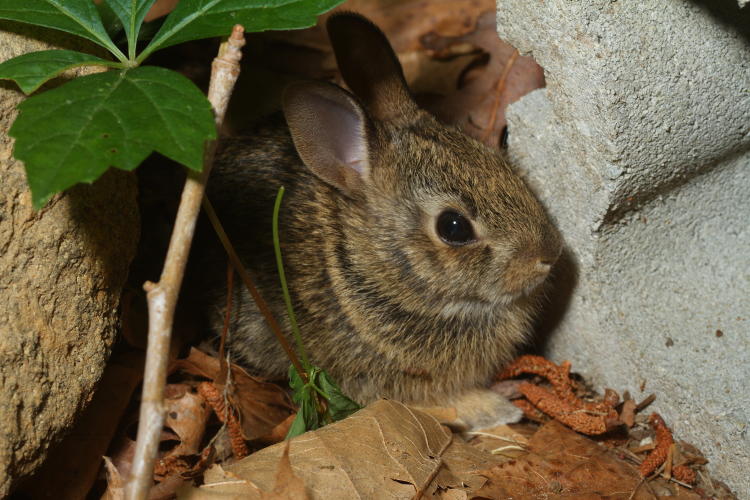
I finally got out and did a couple of shooting sessions, all local (meaning the front and back yards and the pond nearby,) so I have a few photos to post – no real theme, so these will be all over the place. The most recent is above, a very young eastern cottontail (Sylvilagus floridanus) sitting motionless in the back yard as I did a little nighttime exploring, about an hour ago as I type this initial draft; I hadn’t planned on doing any photography tonight, but this guy made me go in and get the camera. I’d heard a commotion from the neighbor’s yard a bit earlier, something ripping through the leaves, but never spotted anything by flashlight. It was enough noise to sound like squirrels chasing one another, but well after sunset when squirrels aren’t active, and not the sound that deer typically make. I suspected either rabbits in mating/cavorting behavior, or a fox on the chase, and finding this palm-sized spud (and sibling) in the yard not long afterward supports this idea a little – their grass nest may have been disturbed and they scattered. I didn’t heard any squealing, which would have been a definite sign of a fox successfully catching one.
I have to do a brief update on the mantids, of course.

I’ve had, like, five hatchings in the yard now, but they’ve largely scattered in all directions; the best I can say is they seem to always like the big Japanese maple near the door, and some of them are presently residing on another in a pot nearby. This one was likely from the last hatching featured, and no more than 15mm in length, so I backed off a bit to do more of a scale and fartsy shot. Nearby, one twice its size and notably green was within easy camera reach.
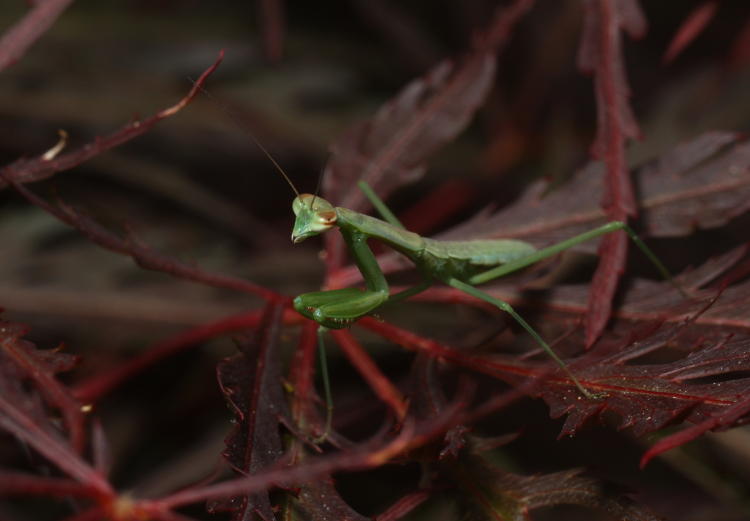
The maple will turn green a little later in the year and the mantids will be able to blend in better then – this kind of reddish-brown is not among their repertoire. One of these days, I’ll either figure out how to tell one specific mantid from another and thus track their coloration changes, or get together a decent terrarium to house a couple within. I think they can only change color between molts, but haven’t confirmed that yet.
If the mantids abandoned the vicinity of their hatchings quickly, the wheel bugs are exactly the opposite.

These wheel bugs (Arilus cristatus) hatched six weeks ago, and every time I’ve checked there’s been a few still hanging out directly on the egg cluster. And yet, from the size, they’re apparently finding food so, good for them I suppose? There are no parents around to annoy, anyway.
A couple more from the yard, and then we’ll go visit the pond.
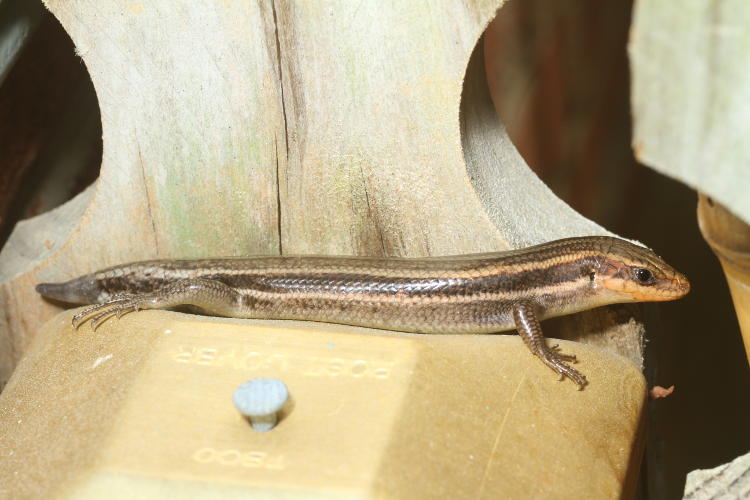
Don’t ask me why I find the Carolina anoles more interesting than the five-lined skinks, even when we have several of the latter that live within easy reach – actually, I can tell you that, because the anoles have cooler skin and look more like Komodo monitors. All that aside, this is an American five-lined skink (Plestiodon fasciatus,) likely female from the coloration, having lost its tail at some point in the past. Don’t ask me, because this is the first I’ve seen of it, but it seems to be growing back, as they will.
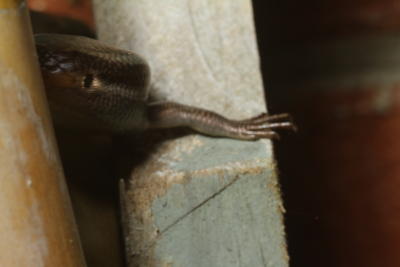 She was being fairly mellow in her basking spot right alongside a gate we were using, but proved she wasn’t stupid by seeking shelter if we drew too close, returning when it seemed safe. A little after the detail shot above, I decided to go for the portrait angle, and maneuvered around to head-on, slowly closing in. Curiously, as I tripped the shutter and the viewfinder blacked out for that fraction of a second, she was gone when my view returned; whether she actually heard the slap of the mirror and shot away that quickly, or her decision to bolt was merely coincidental (I had stopped moving entirely at that point,) I’ll never know, but the resulting image wasn’t quite as intended.
She was being fairly mellow in her basking spot right alongside a gate we were using, but proved she wasn’t stupid by seeking shelter if we drew too close, returning when it seemed safe. A little after the detail shot above, I decided to go for the portrait angle, and maneuvered around to head-on, slowly closing in. Curiously, as I tripped the shutter and the viewfinder blacked out for that fraction of a second, she was gone when my view returned; whether she actually heard the slap of the mirror and shot away that quickly, or her decision to bolt was merely coincidental (I had stopped moving entirely at that point,) I’ll never know, but the resulting image wasn’t quite as intended.
Now we go to the big pond – no, not the Atlantic ocean, a hair smaller than that. While it has an overflow drain engineered into it, that was done before several housing developments nearby all changed the stormwater management for the area, and the pond frequently overflows during heavy rains. This has created a new channel, and when the heavy flow subsides, it leaves behind a few mini-ponds, or deep semi-permanent puddles, and the wildlife have adopted these as legitimate. A few days back, The Girlfriend’s Sprog had spotted numerous tiny frogs hanging out on the banks, and I carefully collected two for a studio session, but they weren’t having it: my photography set wasn’t to their liking and they immediately abandoned it as soon as they were introduced, causing me to pursue them across my desk. So I returned them and tackled some pics right at their home instead.

Now, a few notes. Some idea of the size can be garnered from the surroundings, including the strands of pine straw cutting through the frame, or I can simply tell you that the frogs would fit comfortably on your pinky fingernail. I’m quite sure they’re juvenile, having emerged from tadpole stage within the past couple of weeks, so this is little indication of what the adult will look like, and they remain unidentified, though I’m trying – most guides only show adults, and juveniles often look entirely different. I can tell you from experience that the Copes grey treefrogs look different at this stage, including being twice the size, so I’m sure this is a small species, perhaps a spring peeper or little grass frog, or one of the narrowmouth toads that I’ve definitely found in the exact same area; the head shape doesn’t seem to be indicating that, but who knows? However, I carry little paper scales in my wallet for a reason.

That’s a millimeter scale, so we’re talking 7mm – there isn’t even a full inch visible on the scale within the frame. I was hanging over the edge of the bank by a tiny ‘cliff’ for this perspective, aiming down from above, and was having a hard time breathing since all my weight was directly on my chest, my shoulders and arms hanging out into open space. The things I do for three readers…
At the edge of the pond proper, several different species of frog were alternating sessions of mating calls. I’m never sure what the criteria is, but any species will be silent for a while, then erupt into a chorus of sound among individuals spread out dozens of meters apart, then after 30-60 seconds fall silent again for several minutes; this is most often the various treefrogs, but the green (aquatic) frogs and the bullfrogs also seem to run in waves, the bullfrogs the least erratic of them. I got lucky in tracking down one in particular during a jam.
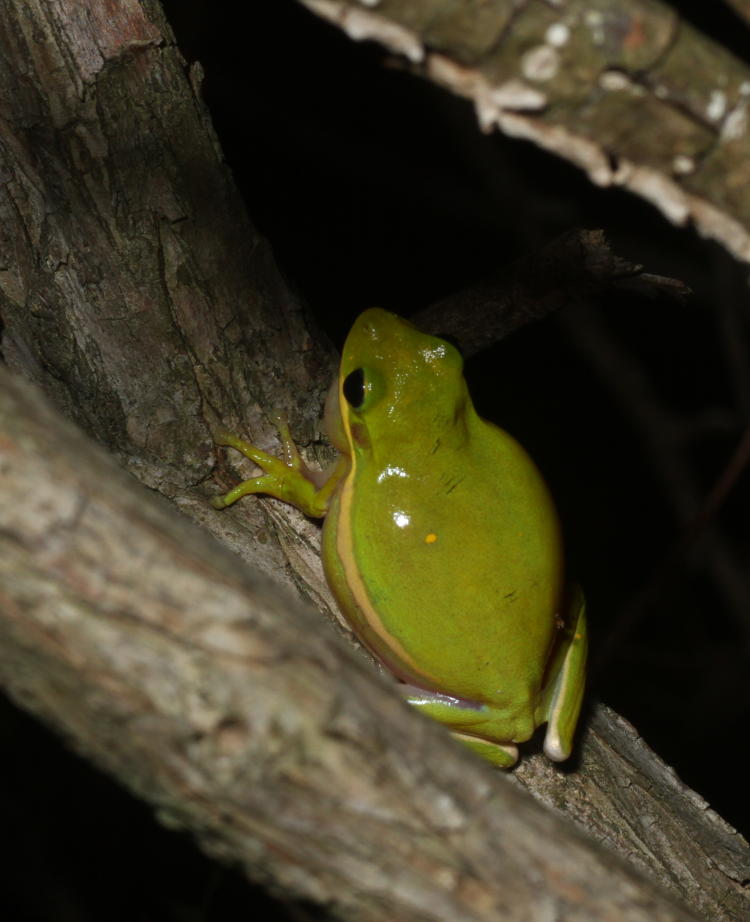
This is a green treefrog (Hyla cinerea,) inflated during a calling session but between actual solos. And then…
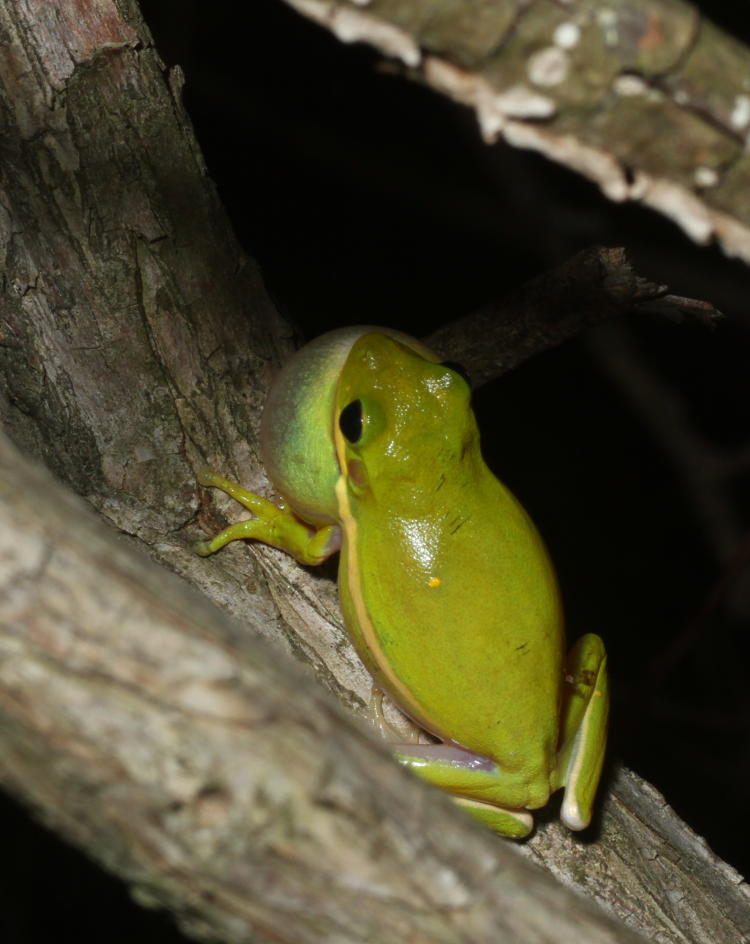
… this is in mid-call, producing the curiously electronic sound that they do. I was not set up to do either video or audio for this session, which I may rectify soon, because attempting to describe their call is a waste of time; it just sounds alien. And the best I can say about their timing is that it seems like they remain silent until one of them in the area gets up enough nerve to sound off, and immediately everyone else, glad that someone had the guts, will chime in and the night will ring with the babble of frogs. Then they quickly peter out, like how audiences decide that the clapping has gone on long enough. This may not be very far from the truth; certainly just one treefrog can be found by sound quickly, but a bunch of them is disorienting. Or I could be talking out of my ass.
We need a profile.
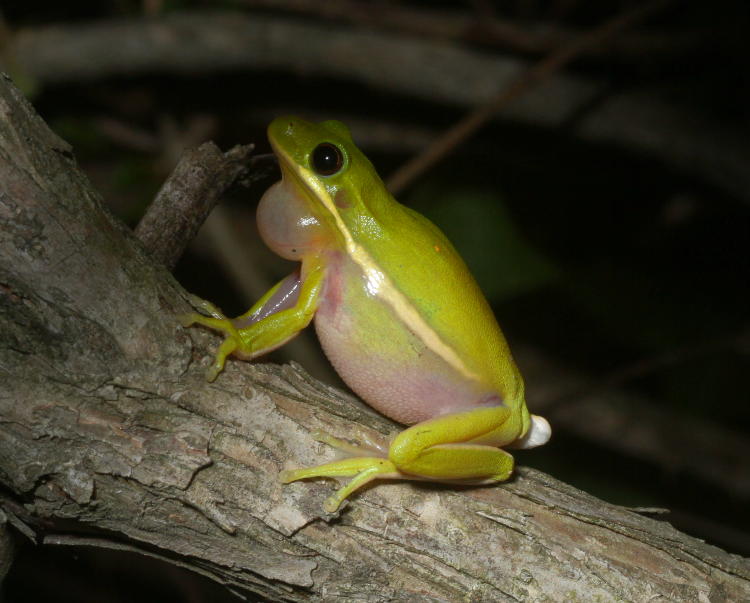
This was just as this individual decided the calling had gone on long enough, though my presence and attempts to get a good angle (by the light of a headlamp) probably had something to do with it. It remained half-inflated in this manner for a few seconds, then abruptly went down to normal proportions and resettled onto the branch.
I have a couple other finds, from earlier that evening as the sun was setting.
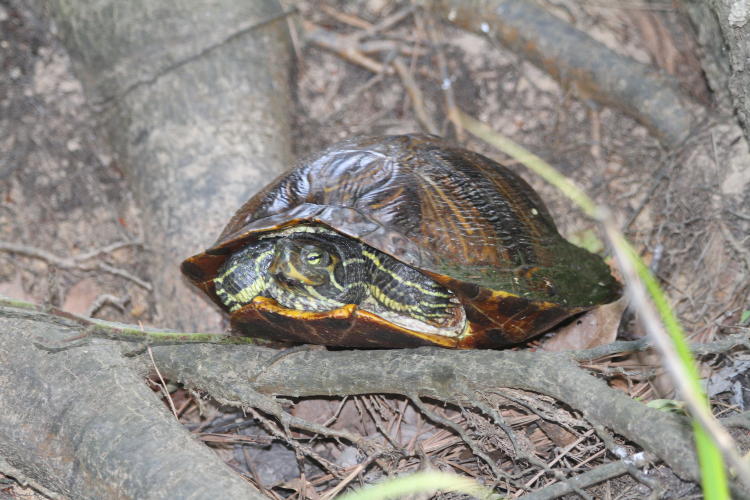
I’m not sure the exact intentions of this yellow-bellied slider (Trachemys scripta scripta) – it wasn’t far from the water, but in an odd location perched on some tree roots. From the shine on the carapace, it hadn’t been out long, but there was no wet trail up to it either. It moved on quickly once I got out of sight, and wasn’t there when I tried to show it to The Girlfriend a couple minutes later.
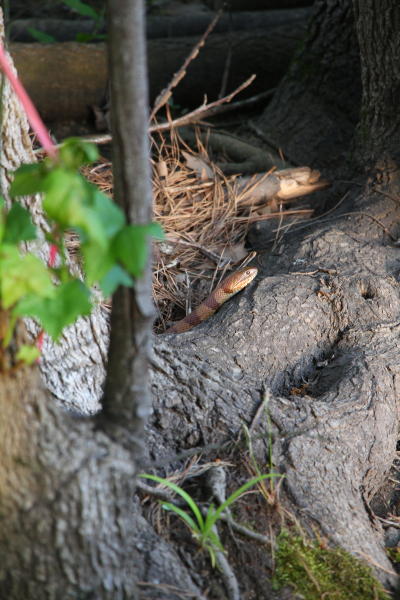 Very close by, however, something else remained put for a few photos. The photo at left is how I first spotted it as I went to the water’s edge to see what might be about, and I was pleased, because this is the first I’ve seen this year – I include the full frame to show you exactly how subtle it was, and it might have been even harder to spot, but the colors were bright and I suspect it had shed its skin very recently. This is a northern water snake (Nerodia sipedon,) which average about a meter in length but thick, like 5 to 8cm in width. I always like to see them because they’re impressive – and harmless, though far too many people can’t identify common snakes in their area and mistake these for either copperheads or cottonmouths, which they do not resemble very closely at all. Now, granted, if you grab one it will bite the hell out of you, unlike some other species, but you have to make the first aggressive move by, you know, grabbing them in the first place. Given their choice, they’ll simply flee.
Very close by, however, something else remained put for a few photos. The photo at left is how I first spotted it as I went to the water’s edge to see what might be about, and I was pleased, because this is the first I’ve seen this year – I include the full frame to show you exactly how subtle it was, and it might have been even harder to spot, but the colors were bright and I suspect it had shed its skin very recently. This is a northern water snake (Nerodia sipedon,) which average about a meter in length but thick, like 5 to 8cm in width. I always like to see them because they’re impressive – and harmless, though far too many people can’t identify common snakes in their area and mistake these for either copperheads or cottonmouths, which they do not resemble very closely at all. Now, granted, if you grab one it will bite the hell out of you, unlike some other species, but you have to make the first aggressive move by, you know, grabbing them in the first place. Given their choice, they’ll simply flee.
No, that’s not the best photo that I obtained.

For this, I had switched from the stabilized 18-135 to the non-stabilized, 20-year-old 100-300 L, a risky move in the fading light, but boosting the ISO and firing off several frames while trying to remain perfectly still produced a usable pic, even at 1/50 second shutter speed (a few times slower than recommended.) I know all my readers are sharp-eyed, and didn’t miss the apparent hook protruding from its back; this is not a normal part of the anatomy, nor is it even protruding, but just a trick of perspective. I was fooled for a bit too, but another frame makes it clearer.
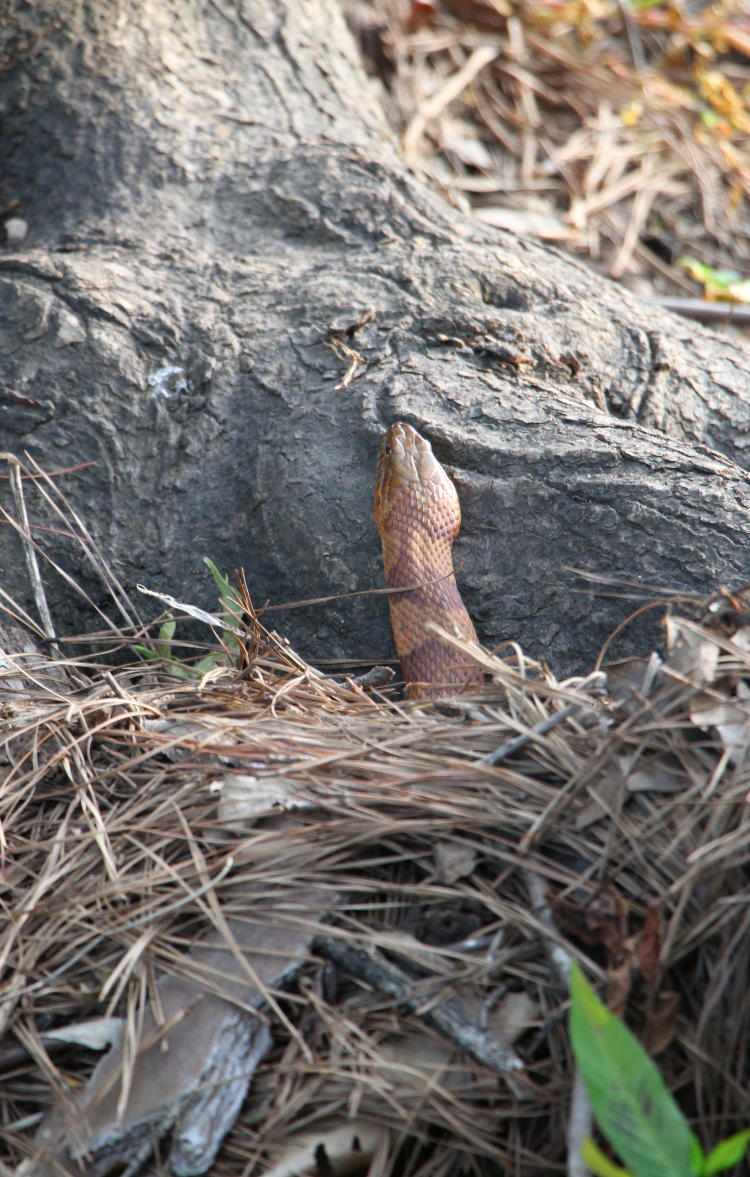
See? Just a bit of the damnable pine straw seen almost end-on. And don’t think I missed the curious shape from this perspective: I named this photo “ThrobbingPython” for a reason, but if you don’t recognize the reference I’ll let you puzzle it out. By this time The Girlfriend had joined me and could see the snake for herself, and I was creeping closer to see just what kind of detail I could get, but the snake revealed that it was not asleep as suspected – another half-step and it launched itself from this spot and sped for the water.
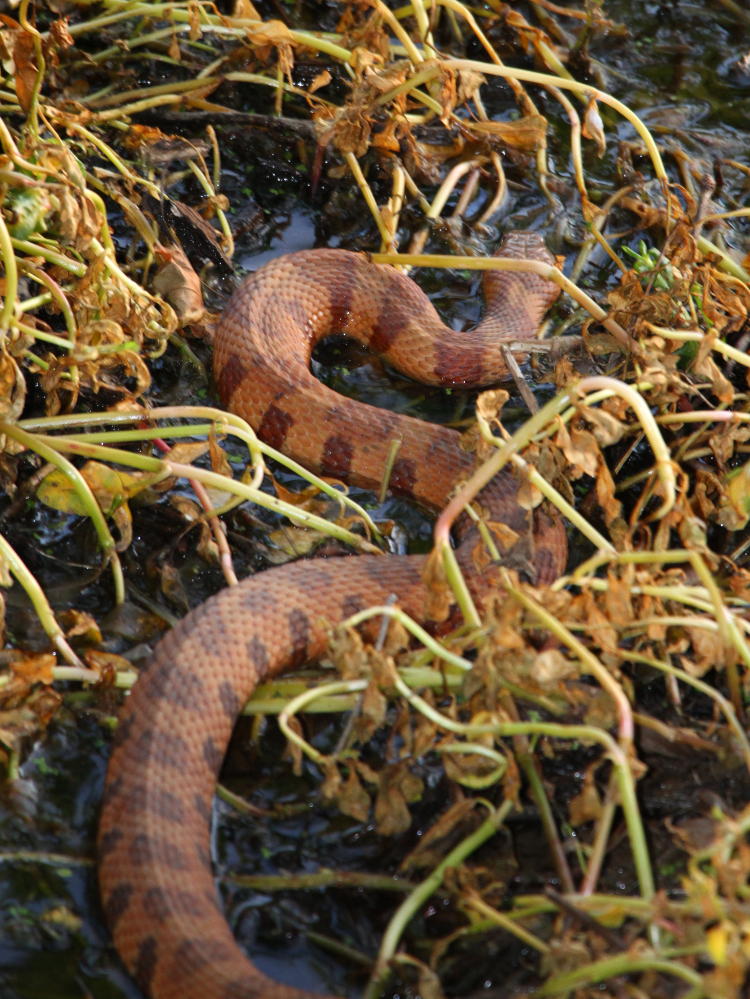
Had it kept going at its original pace, I wouldn’t have had this photo, but it paused at the weeds (poisoned by the HOA in the area to prevent them from “taking over the pond,”) to debate its best course, and I could get a few more frames. Displayed now are the markings which distinguish it from the near-identical banded water snake, which are the broken bands towards the tail; the banded water snake has intact crosswise stripes. Some nice colors, though.
Okay, two more, and then you can go. I expect to see you back within a few days, though.
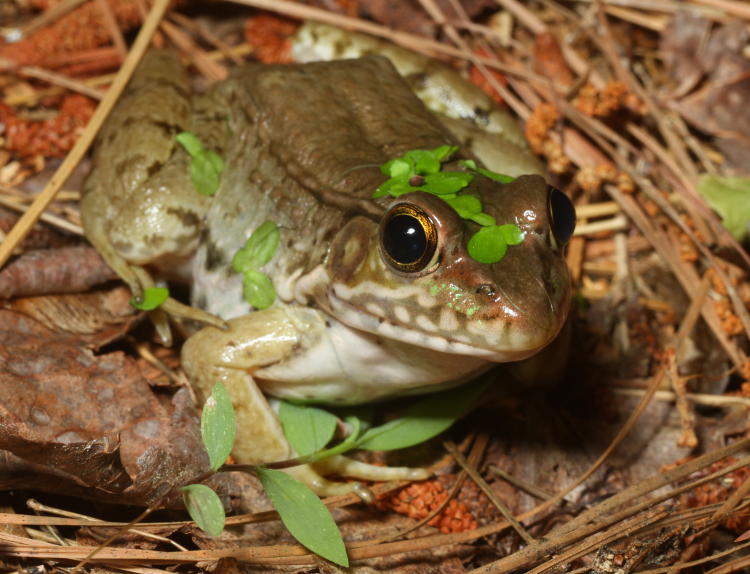
We return to the backyard for the last two. I’d brought back some aquatic species and shells from last year’s trip to New York, and dumped them into the backyard pond when I was done with them; this included a few leaves of genuine NY duckweed, which this spring took a firm hold and completely shielded the water’s surface. Which is evidenced by this green frog (Lithobates clamitans,) one of the three or four residents in the pond, at this point out foraging in the yard. I don’t know if this is accidental or intentional, but it’s a dashing look, don’t you think? Sets off the nostril speckles nicely.
And another, quite-common-now resident of the yard.

I believe this Copes grey treefrog (Hyla chrysoscelis) had been sheltering under the grill cover when I removed it to use the grill the other evening, and extricated itself to perch on top, whereupon I moved it to a lawn chair, a maneuver it treated with aplomb. Just had to show off those eyes.




















































